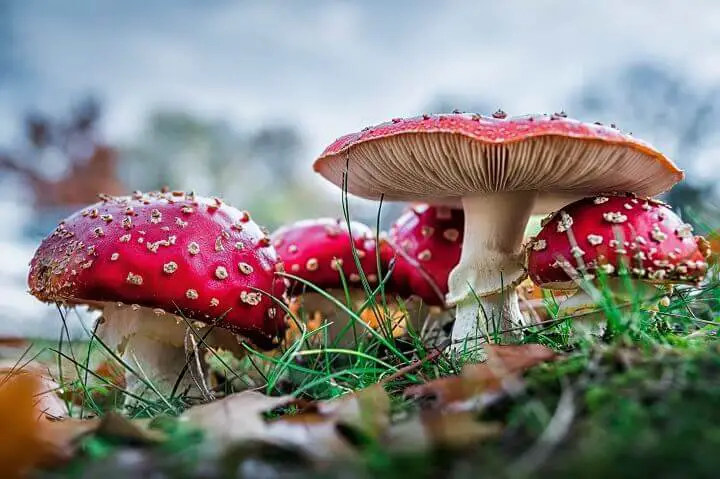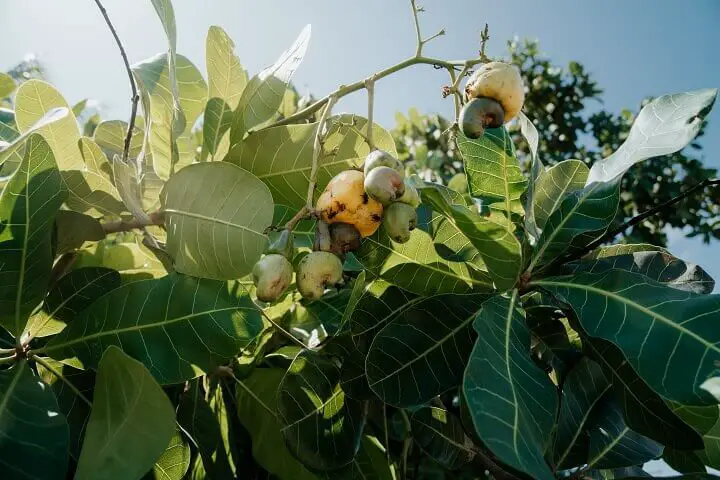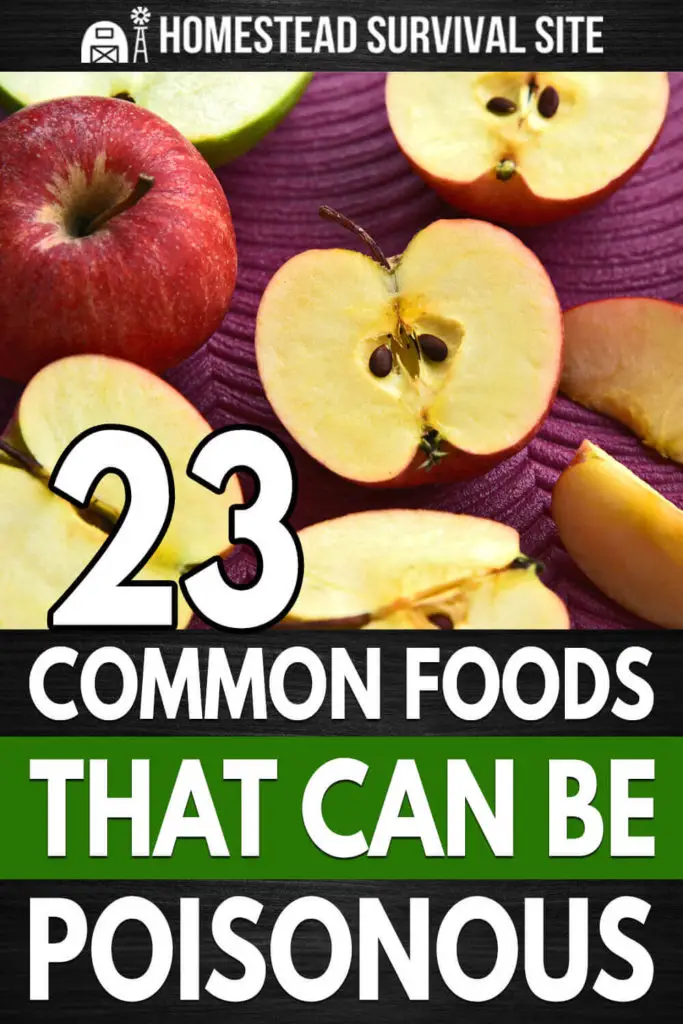Estimated reading time: 8 minutes
When it comes to poisonous foods, you may recall warnings you’ve read about eating fugu, the Japanese word for pufferfish. And for good reason. Unless it is cooked to precise specifications, pufferfish can be over 1,000 times more lethal than cyanide.
However, exotic foods are not the only ones that can be toxic to humans. In fact, you probably have some poisonous foods in your kitchen right now. A surprising number of pantry staples contain hazardous – and possibly deadly – compounds. Here is a list of 23 common foods that can be poisonous.
Want to save this post for later? Click Here to Pin It On Pinterest!
Apple seeds
Did you know that apple seeds contain cyanide? Fortunately, the seeds have a protective coating that protects the poison from entering your system. If you accidentally swallow a few seeds when eating an apple, you will be fine.
However, chewing a large number of apple seeds could put you at risk for cyanide poisoning, which is characterized by rapid breathing, vomiting, and seizures and can be fatal. The good news? An average apple contains five to eight seeds, and the average person would need to consume more than 150 crushed seeds to be at risk.
Stone fruit pits
The fruit of cherries, pears, plums, apricots, and peaches is sweet and delicious, but take care not to eat the pits, bark, or leaves. These components contain amygdalin, the compound that produces cyanide. If you swallow an unchewed pit, it is likely to pass through your system without harm. However, just as with apple seeds, you should avoid chewing or crushing the pits.
Mushrooms
While many mushrooms are safe to eat and add considerable flavor to our meals, certain varieties can be deadly. And, when they are growing in the wild, it can be challenging to tell the difference between the safe kind and the dangerous ones.
Symptoms from consuming poisonous mushrooms can include abdominal pain, vomiting, intense thirst, and liver failure. Severe cases can lead to coma and death. According to an 18-year analysis published by the National Library of Medicine in 2018, 704 Americans (39 per year) experienced serious illness, and 52 (nearly three per year) died after consuming poisonous mushrooms.

Potatoes, Tomatoes, Peppers and Eggplants
Potatoes, tomatoes, peppers, and eggplants are all members of the nightshade family. Although they contain nutrients and powerful antioxidants, these foods also contain solanine and other substances that may contribute to autoimmune conditions, such as inflammatory bowel disease.
To avoid any harmful effects, avoid eating green or sprouted potatoes. The leaves, sprouts, and underground stems (or tubers) of potatoes contain glycoalkaloid, a toxic substance that can cause nausea, stomach cramping, vomiting, diarrhea, headaches, confusion, and death. Glycoalkaloid is also found in the leaves of eggplant, pepper, and tomato plants. Also, avoid eating raw eggplant to lower your risk.
Almonds
Raw bitter and sweet almonds contain levels of poisonous hydrocyanic acid. Research studies indicate that swallowing as few as six to 10 raw bitter almonds can cause serious poisoning in an average-sized adult, while consuming 50 or more can be fatal.
Almond poisoning is unlikely if you buy sweet almonds from a U.S.-grown almond tree. The sweet almonds sold in U.S. grocery stores almonds contain only 25.2 milligrams of cyanide per kilogram of weight, according to a research study. The Food and Drug Administration prohibits the sale of bitter almonds in the U.S.
Rhubarb leaves
The stalk of the colorful rhubarb plant is used to make rhubarb pie. Just be careful not to eat rhubarb leaves, which contain poisonous oxalic acid. The acid binds to calcium, making it difficult for your body to absorb this essential mineral. Symptoms of oxalic acid poisoning include blood clotting problems, kidney stones, diarrhea, vomiting, and coma.
Elderberries
Dark, tasty elderberries are known for their antioxidants and the boost they offer the immune system in warding off the cold or flu. However, consuming unripe elderberries or the leaves or bark of the plant can be toxic. The culprits are lectin and cyanide, two chemicals that can trigger nausea, vomiting, and diarrhea.
Nutmeg
There’s probably a jar of nutmeg in your spice cabinet. When used in small amounts, the spice adds a nutty flavor to home-baked goods. However, when consumed by the spoonful, it can be harmful to the body. Nutmeg contains myristicin, a compound that can cause headaches, drowsiness, dizziness, confusion, hallucinations, and seizures. Ingesting as little as two teaspoons of nutmeg can be toxic.
Kidney beans
Raw red kidney beans have a high concentration of lectin, a toxin that can lead to stomach cramping, vomiting, and diarrhea. In order to get rid of lectin, you need to soak raw beans in water for several hours and then boil them for 30 minutes. It only takes a small handful of uncooked kidney beans to cause painful side effects. That’s why you might be better off sticking to canned kidney beans rather than raw ones.
Lima Beans
Raw lima beans contain linamarin, a chemical compound that can turn into poisonous hydrogen cyanide. You need to cook the raw beans for several hours and then drain them thoroughly to get rid of the compound. As with kidney beans, it may be that canned lima beans are the way to go.
Cashews
Cashews you purchase in the supermarket have been steamed or roasted to remove urushiol from their shells. If that toxin sounds familiar, it’s because it’s the same compound found in poison ivy and poison oak. If you are sensitive to urushiol, eating raw cashews that have not been steamed can cause a severe, if not fatal, allergic reaction.

Mangoes
The skin, bark, and leaves of mangoes also contain urushiol, the same toxin found in poison ivy and poison oak. If you like the tropical taste of mango – and who doesn’t – make sure you peel the fruit completely and avoid consuming any other parts of the plant. A urushiol reaction can include swelling, rash, and breathing difficulties.
Honey
Raw, unpasteurized honey contains compounds called pyrrolizidine alkaloids. While most healthy adults can handle a teaspoon of honey in their tea, the same amount can be toxic to young children and pregnant women. For these individuals, ingesting more than a teaspoon of unpasteurized honey could lead to dizziness, headaches, nausea, or even death.
Cassava
Native to South America, cassava is a root vegetable that is used to make tapioca. Tapioca is a common ingredient in puddings and bubble tea, and it is used as a thickening agent in some recipes. Although the vegetable contains many nutrients, it contains hydrogen, making it poisonous when eaten in its raw state. The Centers for Disease Control recommend soaking sweet cassava tubers in water for about five days.
Other potentially poisonous foods to watch out for:
Peanuts
About 3 million Americans are allergic to peanuts. The most life-threatening response is anaphylaxis, which can lead to airway constriction, shock, and loss of consciousness. Peanuts are the most common food allergy in children in the U.S., affecting about 25% of children with a food allergy, and are a leading cause of allergy-related childhood deaths.
Shellfish
Although people of any age can develop an allergy to shellfish, it is more common in adults. And, among adults, it is more common in women. A severe allergic reaction to shellfish can restrict breathing and become life-threatening.
Raw Meat and Uncooked Eggs
Raw meat and uncooked eggs can contain salmonella, a life-threatening form of bacteria. People with immune deficiencies, the very young, the very old, and pregnant women are particularly vulnerable to salmonella infections.
Castor Oil
Used for centuries for its anti-inflammatory properties, castor oil comes from the castor bean plant, which contains a toxic compound called ricin. Before purchasing castor oil, confirm that the processing of the beans followed safety guidelines to remove the poison.
Bean Sprouts
Since 1996, more than 30 different outbreaks of food-borne illnesses have been traced to raw bean sprouts. Often used on sandwiches and salads, raw bean sprouts can harbor E. coli, listeria, and salmonella. The reason is the sprouts are grown in a warm, humid environment where these dangerous organisms can thrive. Proper cooking can kill the bacteria, but experts recommend that children, the elderly, pregnant women, and individuals with compromised immune systems avoid eating bean sprouts.
Tuna
Tuna has a high mercury content compared to most other fish. The higher levels are due to the fact that tuna feed on smaller fish that already contain amounts of mercury, and the toxin tends to build up in the tissues of tuna over time.

Mercury exposure is linked to anxiety, depression, heart disease, and impaired infant development. Healthy adults should limit their tuna consumption, and children, the elderly, and the immune-compromised should avoid eating this fish, according to experts.
What to do if you suspect poisoning.
The typical signs and symptoms of food-related poisoning include:
- Nausea
- Vomiting
- Diarrhea
- Difficulty breathing
- Drowsiness
- Confusion
- Burns, rashes, redness, or swelling
Symptoms of life-threatening food poisoning include:
- Diarrhea for more than three days
- Fever above 101.5°F
- Difficulty seeing or speaking
- Severe dehydration (indicated by dry mouth, little to no urination, and difficulty keeping fluids down)
- Bloody urine
If you are concerned about possible poisoning, you can call the Poison Help Line at 800-222-1222.
Like this post? Don't Forget to Pin It On Pinterest!












